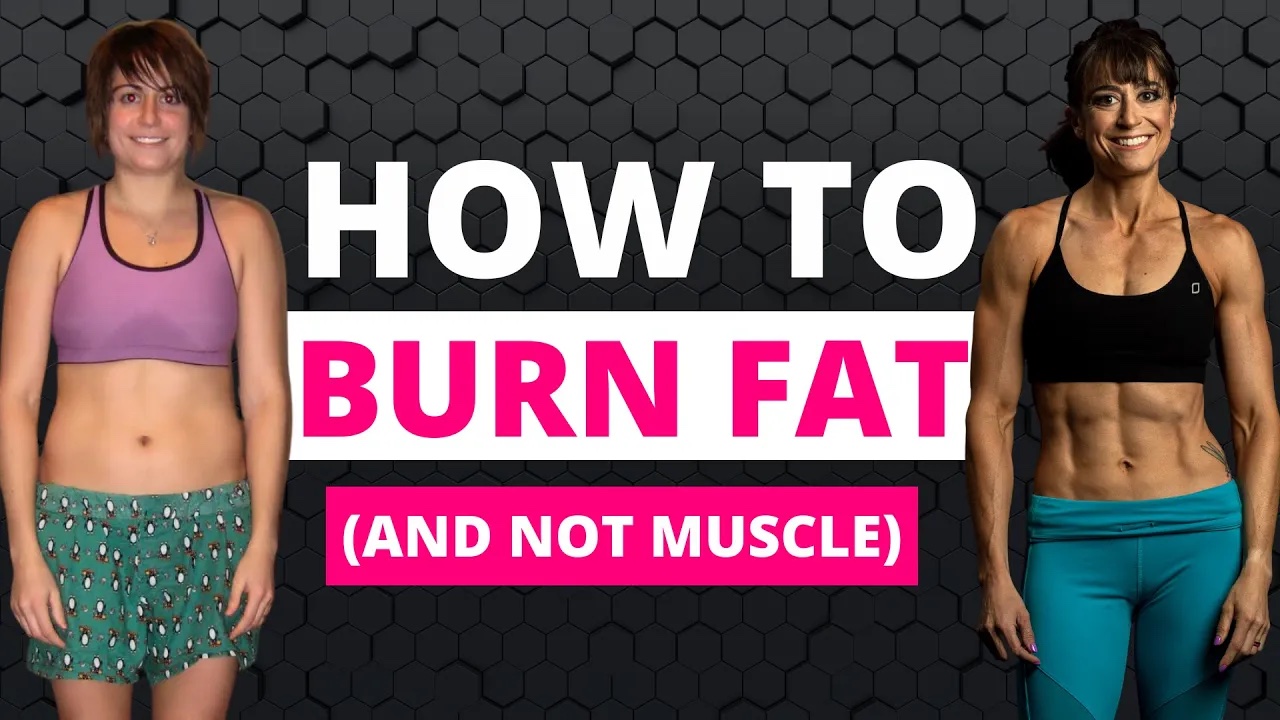
5 Tricks To LOSE FAT (That Actually Work)
Stop believing that losing weight and maintaining your results has to be a full time job.
Because it doesn’t.
And the more we act like it has to be, the more we’re ultimately sabotaging ourselves.
We’re just creating unsustainable habits that, while they may yield some fast initial results, also lead to a quick plateau and us just regaining the weight and even more.
To help you stop this extreme dieting cycle I’d found myself also caught in for years, I want to share 5 weird but extremely effective weight loss tips to help you build your leanest, strongest body ever.
And I’m going to start by telling you the oddest sounding weight loss tip ever…
Stop focusing on losing weight!

That goal weight you have in mind, that you’ve tried countless times to get back to, is actually stopping you from losing weight.
It’s causing you to try to out exercise and out diet time.
It’s causing you to eat less as you train harder, which doesn’t make you actually lose fat any faster.
Our singular focus on the scale and that number changing leads to burn out and metabolic adaptations that make each weight loss attempt harder and harder.
Instead we need to focus on multiple ways of measuring success and even step away from the scale for a bit.
Because it isn’t that number on the scale we are truly after – it’s how we FELT at that weight that we want back.
And that FEELING isn’t truly attached to the number. It’s how energized we felt. The PRs we could set.
It’s how we looked in that dress or bathing suit or in those vacation photos.
We want to look toned and leaner and feel fabulous and strong and youthful.
That number just represents that time and FEELING for us.
But focusing only on that number being our only measure of progress often leads to us giving up on habits that are working…habits that would yield the results we want if we gave them time.
Because the scale doesn’t really show us true fat loss happening, especially as we retain and even gain muscle.
And the better our body recomp results, often the slower the scale will shift.
Because there is no rushing fat loss.
The scale only changes faster because we’re losing water weight or depleting our glycogen stores or even losing as much fat as muscle.
So if you want to truly FEEL the way you felt at your goal weight, step off the scale.
Start taking progress pictures and measurements.
Use an article of clothing you felt fabulous in to track progress based on how it fits.
But stop sabotaging yourself and giving up on the habits you need because the scale isn’t changing quick enough.
Results will NEVER happen fast enough.
But we need to celebrate the other signs of success, such as improved energy, better sleep, crushing our workouts and inches being lost, that show us the habits are working so we stick with them and results can snowball!
The next weird tip, and it’s more a way of thinking about how to make diet changes is to…
Build your diet based on meals you love.
When we think about adjusting our diet, we go to all the foods we “can’t” have and then find diet meals we now need to make.
This makes us honestly often feel deprived and really not enjoy our lifestyle. It makes us dream of going back to what we were doing.
And this is why the changes don’t stick.
We’ve got to evolve our diet to match our needs and goals.
So instead of focusing on diet meals, take meals you already eat and love and find ways to adjust them to match your goals.
Love pizza?
How can you add a bit of protein to your pizza? How can you adjust the portion with maybe a side of veggies to lower calories and increase your micronutrient intake?
Love pasta?
Can you add in an extra ounce of protein? Can you swap the type of pasta to a chickpea or lentil that may boost protein?
Take the dishes you ultimately want to enjoy and find ways to tweak them so you aren’t feeling like everything you love is being cut out or that your meal prep and cooking habits all of the sudden have to shift so dramatically you’re miserable!
But stop making yourself extra miserable trying to completely overhaul your diet!
The third tip is something some of you may hate to hear and others may love…
Cut back on steady-state cardio!
So there is a lot to this tip…And first I want to address those of you who love endurance cardio sessions and want to mentally do everything you can to fight against this tip…
First, if you love running or cycling, I’m not telling you not to do it.
But if you’ve been struggling to lose weight and see the muscle definition you want, you may want to cut back on your mileage for a bit or really acknowledge the cost of doing this cardio and make massive changes to your strength workouts and diet to account for this activity.
For those of you who refuse to cut back on the cardio…
Slow down your other strength workouts and lift heavier with lower reps and longer rest periods while increasing your protein more than you want to and even de-prioritizing your endurance sports to focus on your lifting when you’re fresher.
Now for those of you who are thinking, “I don’t like cardio but it’s always helped me lose weight in the past.”
Think about that statement…you’re here because you need to lose weight AGAIN.
So as a long-term strategy, cardio didn’t work.
And part of the reason why is we’ve often used it to try to out exercise our diet instead of making dietary changes.
But also because we haven’t really built muscle and have even lost it in the process of eating less as we try to burn more. This negatively impacts our metabolic rate and how many calories we burn not only in our workouts but at rest.
And the more calories we burn at rest, the more muscle we have, the more toned we will look and the easier our results will be to maintain.
So instead of turning to cardio, focus on strength workouts. Whether you challenge yourself with bodyweight sessions or hit the gym to lift, focus on building muscle!
This next tip was one of the weirder realizations for me but also why I feel I’m able to stay leaner all year around…
Stop acting like the person always on a diet.
When we’re working to lose weight, we can feel like the friend who can never eat out. We can feel weird at parties or celebrations.
We can feel like we have to avoid the baked goods at work or office lunches.
We can feel a bit like we have to isolate ourselves and not really have fun.
No wonder most of us dread making diet changes and ultimately fall off the healthy habits we are trying to build.
But we often do this because we feel this need to be perfect. To eat clean based on what someone told us a healthy diet should look like.
We also don’t own who we are, our current lifestyle and what we want our lifestyle to look like.
We approach habit changes as being these very set things we have to do in one rigid form instead of finding ways to implement them to match what we need.
If your friend invites you out to dinner at your favorite restaurant, instead of saying no, instead of trying to deprive yourself of a meal you love, plan it in.
Maybe you go lower calorie and higher protein earlier in the day to then have flexibility at that meal.
Instead of feeling like you’ve ruined the day, just focus on that portion control and getting right back into your healthy habits the day after too.
Don’t let the dinner become multiple meals.
If you loved the baked goods someone surprised you with at work, maybe you have one.
But instead of feeling guilty for it so that you end up eating 10 or forgetting about your healthy meals the rest of the day, just enjoy it and even adjust your other meals to create a balance.
So often we try to force this perfection on ourselves over realizing that some LIFE being included in our habit changes is what allows us to actually create new healthy sustainable habits that allow progress to truly build.
And not only can we work in those things we love, but we can change how we spend time with family and friends.
Not every celebration has to revolve around food. Quality time with friends and family can be active as well.
Think about new things you want to try and explore other opportunities to spend time with loved ones that even supports the new healthy habits you want to create! You may be surprised by how much they enjoy exploring new activities too!
And the final tip I’ve found to be super key in not only achieving amazing body recomp but sustaining it over the course of the year is to take more movement snacks.
I think so often we put this emphasis on working out and working out intensely over just moving more.
But the more we are active, the more we want to be active. And the more active we want to be often the more we want to do other healthy habits to support the fact that we feel good!
The more we do, the more we do.
So throughout the day, include movement snacks.
Get up and do something if even just for a minute or two. Listen to a song or quick podcast and walk around your office.
Get up and stretch to reverse sitting hunched over.
Get up between episodes of your nightly TV shows and go roll out or even wash dishes quickly.
Do a quick post dinner walk.
But get up and move around.
The less we’re just seated, bored, lazing around doing nothing, the less likely we are to just indulge in mindless eating.
And often a big habit we have to break, on top of the benefits alone of moving more, is that mindless eating and especially the desire to eat later at night while watching TV.
But just trying to willpower our way through this desire can often lead to losing the battle when stressed because we haven’t shifted our patterns or environment.
That’s why these movement snacks can be key.
We aren’t focusing on what we shouldn’t be doing. We’re focusing on something good we want to do.
This mindset shift and focus helps as it feels positive over us feeling like we’re FIGHTING something.
Plus, moving more does mean we burn more calories at rest, helping keep our metabolic rate overall higher.
And while no, we don’t want to just focus on doing more to burn more calories, being more active does help our health and weight loss results!
But use these 5 tips to help meet yourself where you are at and make sustainable habit changes that build.
Stop trying to just force some cookie cutter plan on yourself and instead truly focus on how you can adjust your lifestyle and shift your mindsets around the habits that lead to you seeing the results you want!
And if you’re ready to build your leanest, strongest body at ANY age…yup NEVER too old!…schedule a coaching consultation call below. I’d love to help you see the results you deserve!






